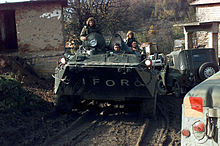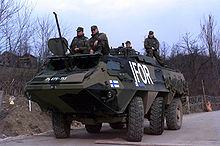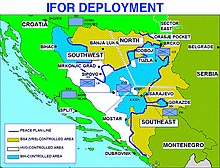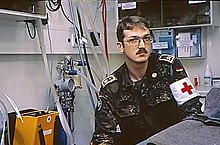Implementation Force




The Implementation Force (dt. Implementation Force ), short IFOR , described the under NATO command standing multilateral peacekeeping force , which on 20 December 1995 in Bosnia and Herzegovina , the UNPROFOR replaced and activity in the framework of Operation Joint Endeavor recorded. On December 21, 1995, the NATO air operation Deny Flight , which had existed since April 1993, was discontinued. This was followed on January 9, 1996 by the suspension of the airlift to Sarajevo that had existed since July 1992 as part of Operation Provide Promise .
history
The founding was preceded by difficult negotiations that only led to an agreement between the conflicting parties in the former Yugoslavia on November 21, 1995 in Dayton , Ohio , following massive international pressure . IFOR should implement the military aspects of the Dayton Peace Agreement .
After the United Nations Security Council defined and established the IFOR in Resolution 1031 on December 15, 1995 , NATO was commissioned to monitor the ceasefire agreements and the disengagement of forces. 16 NATO and 17 non-NATO countries, including 14 countries from the NATO Partnership for Peace (PfP) program, including Russia and Ukraine , took part in this first NATO mission, outside of its previous role as a collective defense alliance . Since the end of the Second World War , this was also the first joint military operation between the “superpowers” United States and Russia.
On May 18, 1996, the IFOR mission was extended by the NATO Council to include support for reconstruction.
Through the UN resolution 1088 of December 12, 1996, the IFOR mandate was transferred to the successor mission SFOR .
Scope and deployment
The nominal strength of the IFOR was around 57,000 soldiers , of which the USA provided around 20,000, Great Britain 13,000 and France 7,500. The NATO command of IFOR was politically subordinate to the North Atlantic Council and militarily to the Supreme Headquarters Allied Powers Europe (SHAPE) and its Supreme Allied Commander Europe (SACEUR) General George A. Joulwan (USA). SACEUR again commissioned the Commander in Chief (CINCSOUTH) of the operational command area of the Allied Forces South Europe (AFSOUTH) in Naples to lead the Implementation Force (IFOR) with headquarters in Sarajevo. On November 7, 1996 a change followed within the IFOR leadership from the NATO command area AFSOUTH to the Land Forces Central Europe (LANDCENT), which belonged to the Allied Forces Central Europe (AFCENT) with headquarters in Brunssum (Netherlands).
IFOR was again subdivided into three command areas:
- Allied Naval Forces South (NAVSOUTH), the naval forces within the command area of Allied Forces South Europe (AFSOUTH) under the command of Commander Allied Naval Forces South (COMNAVSOUTH)
- Land Component Command this included the corps headquarters Allied Command Europe Rapid Reaction Corps (ARRC), which was relocated from Mönchengladbach to Ilidža . The three command contingents or multinational divisions (MND) were subordinate to the ARRC, the command of the IFOR (COMIFOR) and the commander of the ARRC (COMARRC) led jointly.
- Air Component Command , which included the Combined Air Operations Center (CAOC) and Regional Air Movement Control Center (RAMCC) - an expanded 5th ATAF (Allied Tactical Air Force or Luftflottenkommando) of Allied Air Forces South (AIRSOUTH) - in Vicenza ( Italy) as NATO's tactical command post for coordinating the air operations of the forces assigned to it
The headquarters for the supply of the IFOR contingents (Logistic Support HQ) was located in Zagreb, Croatia and was subordinate to the IFOR Commander for Support (C-SPT). There was also an office of the NATO Maintenance and Supply Agency (NAMSA) in Split .
The operational areas and multinational divisions (MND) in Bosnia and Herzegovina and Croatia were deployed as follows:
- MND (N) - Multinational Division (North) with headquarters in Tuzla
- Guided tour of the USA (American sector) with Task Force Eagle (including the 1st US Armored Division ) with headquarters in Tuzla and Vlasenica
- in addition, from January 6, 1996, an independent Russian brigade (RUSBDE) with 1,500 soldiers, mostly paratroopers, under the leadership of Colonel General Leonti Pavlovich Shevtsov, with headquarters in Ugljevik and bases in Prijob, Simin Han, Milijas, Spasojevici , Vukosavci and Koraj
- a mixed Nordic-Polish brigade (NordicPolish-Brigade; NORDPOL BDE) with contingents from the Scandinavian countries Finland, Norway, Denmark and Sweden as well as from Poland with headquarters in Doboj . In total, the brigade comprised 2,755 soldiers, supported by 220 US soldiers
- MND (SW) - Multinational Division (Southwest) (British Sector) with headquarters in Banja Luka , later in Gornji Vakuf
- Guided tour of Great Britain , consisting of a British brigade with headquarters in Šipovo
- MND (SE) - Multinational Division (Southeast) (French Sector) with headquarters in Mostar
- Guided tour through France with a French brigade with headquarters in Mostar and Rajlovac near Sarajevo
- a brigade from Spain with headquarters in Medjugorje
- a brigade from Italy with headquarters in Sarajevo-Zetra
guide
The designation of the IFOR commander was COMIFOR (Commander Implementation Force):
- December 20, 1995 to July 31, 1996: Admiral Leighton W. Smith , USA
- July 31, 1996 to November 7, 1996: Admiral T. Joseph Lopez , USA
- November 7, 1996 to December 12, 1996: General William W. Crouch , USA
The German contingent GECONIFOR
The soldiers of the German contingent GECONIFOR (L) ( GErman CONtingent Implementation FORce (Land) ) were based in Zadar ( army aviators ), Benkovac ( pioneers ), Šibenik (operational support: replenishment and repair ), Camp Solaris (transport), in Trogir ( paramedics with field hospital ) and Primošten ( military police ).
The 1st Army Contingent of the Bundeswehr for IFOR in January / February 1996
The army of the army put down the end of January 1996 under the leadership of Lieutenant General Friedrich Riechmann the first major contingent for GECONIFOR (L) with around 2,600 soldiers ready. Previously, so-called advance commands from December 22, 1995 had prepared the infrastructure of the subsequent properties. GECONIFOR was divided into 4 task forces and a field hospital:
- Transport task force
- The lead organization was the Transport Battalion 133 from Erfurt with approx. 550 soldiers, equipped with 6 heavy-duty transporters. Attached to this was a security company consisting of the mountain armored reconnaissance company 230 (GebPz AufklKp 230) from Freyung as well as the 2nd company of the mountain hunter battalion 231 (GebJgBtl 231) from Bad Reichenhall , equipped with wheeled armored vehicles of the Luchs and transport armored personnel carrier Fuchs , later renamed Trsp ). The tanks were used to escort the German convoys through Bosnia. The association was stationed at Camp Solaris near Šibenik . The first convoy was carried out in mid-January 1996 as a “dress rehearsal” from Šibenik to Livno and back. In the following months, transports took place both to our own German forces in Benkovac and Visoko and to other locations of the IFOR contingent, e.g. B. Ploče and Mostar (French), Banja Luka (British), Sarajevo and Tuzla (USA).
- Mission support association
- The lead organization was the logistics brigade 1 from Lingen with approx. 500 soldiers and the supply battalion 7 from Unna with approx. 180 soldiers, as well as a security company of the mountain hunter battalion 232 from Bischofswiesen equipped with Fuchs armored personnel carriers. Stationed in Primošten and Divulje.
- Pioneer Task Force
- The lead unit was the Pioneer Battalion 1 from Holzminden with approx. 400 soldiers equipped with rapid armored bridges and fixed bridges as well as the construction and operation of field hospitals by means of armored engineer trains. Parts of the engineer battalion were stationed in Benkovac and Visoko approx. 15 km northwest of the Bosnian capital Sarajevo and also near the Bosnian-Serbian border with 22 men in Borci near Konjic to support the " 2e régiment étranger de parachutistes " of the French Foreign Legion . The association's mandate included restoring a road link between Visoko and Sarajevo and clearing mines.
- Army Aviation Unit
- The leading unit of the first contingent until May 1996 was the Army Aviation Regiment 10 in Faßberg with approx. 380 soldiers and equipped with type CH-53 transport helicopters from the Rheine, Laupheim and Mendig locations and Bell UH-1 D from the Fassberg and Niederstetten locations, as well as a security company of the Mountain Infantry Battalion 232/233 equipped with the Fuchs transport tank and the Wiesel weapon carrier .
- Leading organization of the second contingent until October 1996 was the Army Aviation Regiment 6 in Hohenlockstedt with approx. 380 soldiers and an increase of 400 security soldiers for the first free election in October / November 1996. For this purpose, the mountain infantry battalions 232/233 were used as security soldiers.
- After the second contingent, the airfield was closed and the existing forces relocated to Sarajevo / Benkovac. In mid-1998 this mission for the Army Aviation Force ended.
The association was stationed on the premises of Zadar Airport, which supported both German and Allied troops in Croatia and Bosnia and Herzegovina .
- Field hospital
Telecommunications units were also stationed at all locations . The leading association of the telecommunications troops of the 1st contingent was the telecommunications regiment 4 from Regensburg.
Brigadier General Friedrich Riechmann was in command of the 1st and 3rd German Army Contingent . The commander of the 2nd contingent was Brigadier General Henning Brümmer.
In June 1996 a so-called advanced partial command post was set up in Lukavac . The task of around 100 German soldiers from all locations in Croatia was to provide logistical support for the US Army in restructuring the properties in the Tuzla area .
A unit of repair soldiers was stationed in Šibenik within the framework of the EU association, which prepared vehicles with special armor for use, carried out spare parts logistics and repairs. There were also special modifications such as B. Equipping the fox with a combat tower. Most of the approx. 200 soldiers came from Potsdam-Eiche / Golm and were supported by a San area and telecommunications from the local locations, most of which, however, were stationed in Primošten, as the field camp was located there. A larger unit of the Franco-German Corps was stationed in Primošten and was entrusted with security tasks (approx. 150 soldiers).
Performance record of the German armed forces for IFOR
army

By December 18, 1996, the army contingent carried out around 492 convoys and transport missions as well as 1,050 air transport missions by the army aviation. The Pioneers Mission Association renewed or repaired 9 bridges, built 35 km of new roads and renewed road sections over a length of 21 km.
marine
There were 29 missions of destroyers and frigates of the German Navy (multiple missions), 4 tanker missions and 29 MPA missions (maritime surveillance)
air force
Fighter aircraft of the Tornado type flew 1006 ECR missions to protect German and NATO aircraft, as well as 1085 RECCE missions to investigate the armed forces of the former conflicting parties and to monitor the military bases and arsenals. The base was the airfield of the Italian Air Force in San Damiano near Piacenza .
medical corps
The medical service with the field hospital carried out 10,925 outpatient and 2,046 inpatient treatments for patients from 58 nations.
The Austrian contingent AUSLOG / IFOR
Political foundations
The Dayton Treaty also gave the Austrian Armed Forces the opportunity for the first time to take part in a peacekeeping operation outside of a direct UN mission. The basis for this was the UN resolutions 1031 and 1088, implementation was the responsibility of NATO , which meant that Austria, which was actually neutral, could take part in a NATO mission within the framework of the PfP program . Ministerial directive 147/95 of December 15, 1995 laid the national basis for the first Austrian soldiers to be able to start their work in Bosnia as early as January 1996. The mission was named AUSLOG / IFOR (Austrian Logistic Contingent / Implementation Force).
The military use
composition
On February 10, 1996, the main contingent of the First Mission followed, designated as AUSLOG / IFOR 1, under the command of Lieutenant Colonel Günther Kienberger. It consisted of a headquarters company and a transport company with a total of about 300 men (and occasionally a female doctor). The transport company consisted of three transport trains, two of which were equipped with medium-weight ÖAF tippers 16,162 or 16,192 and one with heavy ÖAF trucks 20,320 . Each platoon consisted of 3 groups of 6 trucks each, each truck was manned by two drivers in the rank of NCO or crew. Thus, it was a purely logistical unit that was attached to the NATO combat troops as a support force. A participation of this unit in "violent measures to enforce peace" (ie in combat operations) was not planned by Austria. If there were no military requirements, she also carried out civilian transports (e.g. for the reconstruction project “ Neighbors in Need ” of the ORF and the Austrian Caritas ). In the course of time, the military tasks decreased so much that practically only the reconstruction was driven. Nevertheless, AUSLOG was a force fully integrated into IFOR, to which all military facilities and services were open.
The headquarters company included the usual staff and supply tasks such as security, kitchen, COMCEN and medical supplies. There was almost always a Catholic or Protestant military pastor with the Austrian contingent, although he did not rotate with the other soldiers every 6 months.
Mission preparation
In Austria, the mission was prepared and handled by the Foreign Missions Command. The tank artillery battalion 4 (PzAB4) in Gratkorn was in charge of this, while the supply regiment 1 (VR 1) in Graz was responsible for driving technical training . Despite his long experience with foreign missions (especially Syria / Golan and Cyprus), the mission with NATO in an operational area that until recently had been a war zone was a novelty for the Austrian Armed Forces. Bullet-proof vests and modern combat helmets were leased from the French army in a hurry, so that the Austrian soldiers - otherwise equipped with the field suit 75 - had a fully adjusted resemblance to French soldiers. Every soldier had to undergo an examination of suitability for deployment on the basis of a voluntary report for deployment abroad, during which he was tested athletically, psychologically and medically. In preparation for the deployment, especially from AUSLOG / IFOR 2 and the experience gained through the initial deployment, great importance was attached to self-protection, mine awareness and dealing with illegal roadblocks and local warlords. The soldiers intended as drivers were trained in army driving schools for the requirements in Bosnia, depending on their driving licenses. The trucks were retrofitted with Kevlar plates around the driver's cabs, which were supposed to withstand bullets from infantry weapons up to cal. 7.62 mm NATO. Since the "BH" (Bundesheer) on the license plates could have easily been confused with the initial letters for Bosnia-Herzegovina, it was covered with a red-white-red flag.
Equipment, execution of transport orders, rotations
The contingent was deployed in the BELUGA camp (Belgium, Luxembourg, Greece, Austria) in Visoko 25 km northwest of Sarajevo on the site of the former textile factory VITEX. Inflatable DRASH tents were used inside a hall , which was also a novelty at the time. The convoy trips led either to the vicinity of Sarajevo, or over several days to Croatia, Austria and Hungary. In these cases, other IFOR camps, e.g. B. in Slawonski Brod or Tuzla . Every soldier was armed with the StG 77 (Steyr AUG) , commanders and special functions with the P 80 (Glock 17) , in the camp there were also several MG 74s for reinforcement. The transports were basically carried out as convoys, with trucks and tippers mostly operating separately from each other. At least one Puch G was used as a command and command vehicle, and depending on requirements, a SanKW ( Pinzgauer ) and / or a KranKfz were also assigned.
The replacement took place every 6 months, in February or August. Soldiers who wanted to stay longer than these 6 months could submit a voluntary report for an extension, which was usually also accepted.
In most cases, contact with the population was very friendly. On the one hand, the help of the Austrian soldiers for the reconstruction was perceived very positively, on the other hand Austria still had a good reputation in the Balkans from the time of the Austro-Hungarian monarchy . In addition, especially in Croatia, the rapid recognition of the newly founded state by Austria and its Foreign Minister Alois Mock was extremely helpful.
Transition to SFOR and the end
On December 20, 1996, the Implementation Force (IFOR) changed to the Stabilization Force (SFOR). Their goal was to maintain a secure environment for the continued consolidation of peace, which would subsequently make the presence of NATO-led forces in Bosnia-Herzegovina unnecessary.
On April 1, 1997, Greece followed Belgium as the lead nation. On June 18, 1998, the Belgian and Luxembourg forces passed and were replaced by the Bulgarians. Two days later the camp was renamed from BELUGA to HELBA (HELlenic, Bulgaria, Austria).
On September 14, 1999, the Austrian and German commanders held a meeting regarding the integration of the AUSLOG transport train into the German GECON logistics unit in Rajlovac (5 km northwest of Sarajevo). The first implementation concept for this was already available on November 10th of the same year, a month later a reconnaissance team began with the dismantling of the warehouse and the relocation work in the operational area.
A total of ten contingent rotations were carried out at AUSLOG / IFOR and SFOR, whereby the strength was always reduced in order to free up capacities for other missions. According to the resolution of the Council of Ministers of June 6, 2000, the mission in Bosnia and Herzegovina was completely dissolved by the Republic of Austria in March 2001, as Austria was planning to take part in the EU crisis response force with around 2,000 soldiers . Since January 1, 2000, SFOR staff members have only been sent to Camp Butmir in Sarajevo.
A total of almost 2,000 soldiers from the Federal Army took part in the mission. Over the years 6,800,000 kilometers have been driven and 461,900 tons of goods of all kinds have been transported. The last SFOR commander was Styrian Lieutenant Colonel Dietmar Foditsch.
The vehicles used in action (Puch G, ÖAF Kipper and ÖAF sLkw) were relocated to Austria and were recognizable there for years by their changes for the Bosnia mission (hardening, inscriptions IFOR and SFOR).
literature
- Josef Günter Kienberger: The first deployment of the armed forces within the framework of NATO AUSLOG / IFOR, Bosnia and Herzegovina 1996 . In: Christian Segur-Cabanac , Wolfgang Etschmann (ed.): 50 years of foreign missions of the Austrian Armed Forces (= writings on the history of the Austrian Armed Forces ). Edited by the General Staff of the Federal Ministry for National Defense and Sport and the Army History Museum , Vienna 2010, ISBN 978-3-9502653-1-6 , pp. 651 ff.
Web links
- Official website (English)
- Website of the Austrian Armed Forces
- Article in the magazine Truppendienst
- SFOR drivers in ÖAF trucks
- Troop body badge from AUSLOG / IFOR





